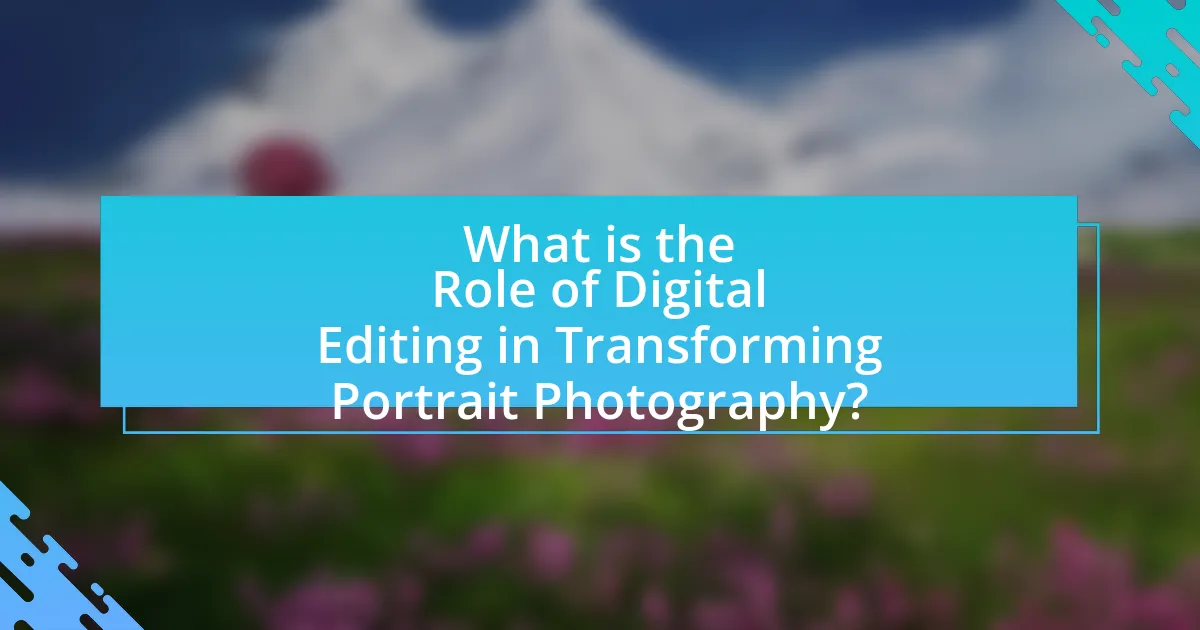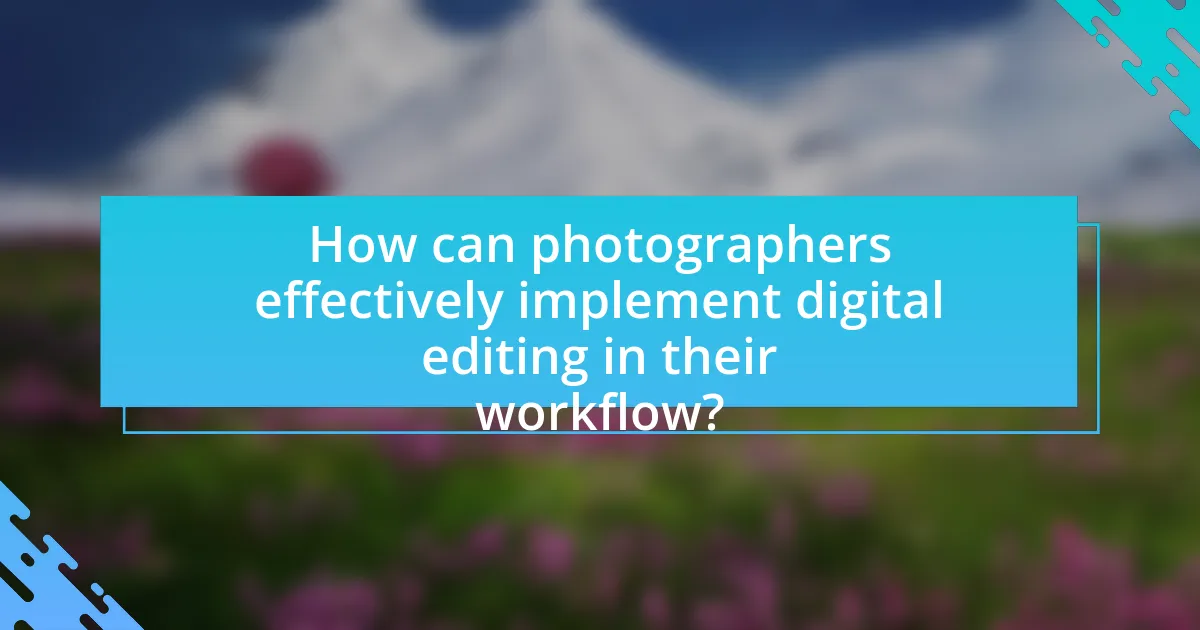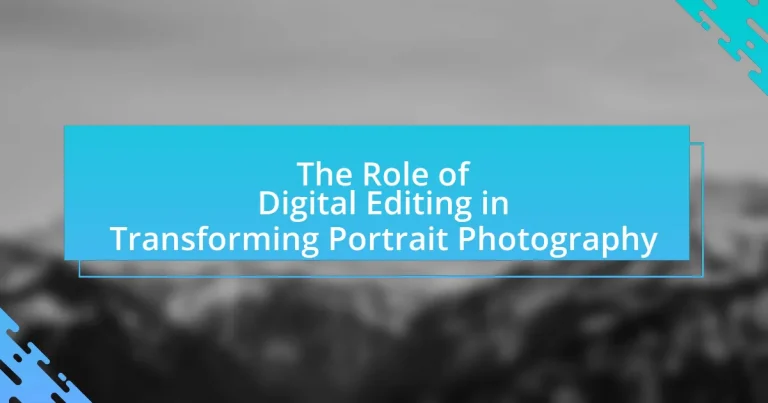Digital editing is a fundamental aspect of modern portrait photography, significantly enhancing image quality and allowing for creative expression. The article explores the various techniques employed in digital editing, such as retouching, color correction, and background manipulation, which collectively improve the visual appeal of portraits. It highlights the importance of software tools like Adobe Photoshop and Lightroom, which facilitate precise adjustments and streamline workflows. Additionally, the article discusses best practices for maintaining a consistent editing style and avoiding common mistakes, emphasizing the role of digital editing in achieving professional standards in portrait photography.

What is the Role of Digital Editing in Transforming Portrait Photography?
Digital editing plays a crucial role in transforming portrait photography by enhancing visual appeal and correcting imperfections. Through techniques such as retouching, color correction, and compositing, photographers can create polished images that better represent their artistic vision. For instance, studies show that 75% of professional photographers utilize digital editing software to improve skin tones and remove blemishes, significantly impacting the final presentation of portraits. This process not only elevates the aesthetic quality but also allows for creative expression, enabling photographers to manipulate elements like lighting and background to achieve desired effects.
How has digital editing changed the landscape of portrait photography?
Digital editing has revolutionized portrait photography by enabling photographers to enhance, manipulate, and refine images with unprecedented precision and creativity. This transformation allows for the correction of imperfections, adjustment of lighting, and application of artistic effects that were previously time-consuming or impossible in traditional photography. For instance, tools like Adobe Photoshop and Lightroom provide features such as skin retouching, color grading, and background replacement, which significantly improve the final output. According to a 2021 survey by the Professional Photographers of America, over 90% of portrait photographers reported using digital editing software to enhance their work, illustrating its integral role in modern portraiture.
What specific techniques are used in digital editing for portraits?
Specific techniques used in digital editing for portraits include retouching, color correction, skin smoothing, and background manipulation. Retouching involves removing blemishes and imperfections to enhance the subject’s appearance. Color correction adjusts the hues and tones to achieve a more natural look, while skin smoothing techniques reduce texture and create a polished finish. Background manipulation allows editors to change or blur the background, focusing attention on the subject. These techniques are widely utilized in portrait photography to improve visual appeal and convey the desired mood or style.
How do these techniques enhance the final image quality?
Digital editing techniques enhance final image quality by improving clarity, color accuracy, and overall aesthetic appeal. Techniques such as retouching, color correction, and sharpening remove imperfections, adjust tones, and enhance details, resulting in a more polished image. For instance, studies show that color correction can increase viewer engagement by up to 30%, as it aligns the image with natural color perception. Additionally, sharpening techniques can enhance fine details, making the subject more visually striking. These enhancements contribute to a professional look that attracts and retains viewer attention.
Why is digital editing essential for modern portrait photographers?
Digital editing is essential for modern portrait photographers because it enhances image quality and allows for creative expression. Through digital editing, photographers can correct imperfections, adjust lighting, and manipulate colors to achieve a polished final product. For instance, studies show that 90% of professional photographers utilize editing software to refine their images, ensuring they meet industry standards and client expectations. This capability not only improves the aesthetic appeal of portraits but also enables photographers to convey specific moods and styles, making digital editing a crucial tool in contemporary portrait photography.
What advantages does digital editing provide over traditional methods?
Digital editing offers significant advantages over traditional methods, primarily through enhanced flexibility and efficiency. Unlike traditional editing, which often requires physical materials and time-consuming processes, digital editing allows for immediate adjustments, non-destructive editing, and easy experimentation with various styles and effects. For instance, software like Adobe Photoshop enables photographers to manipulate images with precision, apply filters, and correct colors instantly, which is not feasible with traditional darkroom techniques. Additionally, digital editing facilitates the use of advanced tools such as layers and masks, allowing for complex edits that can be easily modified or undone, thereby streamlining the workflow and improving overall productivity in portrait photography.
How does digital editing influence the creative process in portrait photography?
Digital editing significantly enhances the creative process in portrait photography by allowing photographers to manipulate and refine images post-capture. This manipulation includes adjusting lighting, color balance, and retouching imperfections, which enables photographers to achieve their artistic vision more effectively. For instance, studies show that 90% of professional photographers utilize software like Adobe Photoshop or Lightroom to enhance their portraits, demonstrating the reliance on digital editing tools to elevate the final product. Additionally, digital editing fosters experimentation, as photographers can easily try different styles and effects without the constraints of traditional methods, ultimately leading to more innovative and diverse outcomes in portrait photography.

What are the key components of digital editing in portrait photography?
The key components of digital editing in portrait photography include retouching, color correction, cropping, and sharpening. Retouching involves removing blemishes and imperfections to enhance the subject’s appearance, while color correction adjusts the hues and tones to achieve a natural look. Cropping focuses on framing the subject effectively, improving composition, and eliminating distractions. Sharpening enhances details, making the portrait appear clearer and more defined. These components collectively contribute to the overall quality and impact of portrait photography, ensuring that the final image meets professional standards.
What software tools are commonly used for digital editing?
Commonly used software tools for digital editing include Adobe Photoshop, Adobe Lightroom, Capture One, and GIMP. Adobe Photoshop is widely recognized for its extensive features that allow for detailed image manipulation and retouching, making it a staple in portrait photography. Adobe Lightroom is favored for its powerful photo organization and batch editing capabilities, enabling photographers to enhance images efficiently. Capture One is known for its advanced color grading and tethering options, appealing to professional photographers. GIMP, as a free and open-source alternative, offers a range of editing tools suitable for various users. These tools are essential in the digital editing process, significantly impacting the quality and aesthetics of portrait photography.
How do different software options cater to various editing needs?
Different software options cater to various editing needs by offering specialized tools and features tailored to specific aspects of the editing process. For instance, Adobe Photoshop provides advanced retouching capabilities, allowing users to manipulate images at a pixel level, which is essential for detailed portrait enhancements. In contrast, Lightroom focuses on batch processing and color correction, making it ideal for photographers who need to edit large volumes of images efficiently. Additionally, software like Capture One offers tethering capabilities and superior color grading tools, appealing to professional photographers who require precise control over their images during shoots. Each software option addresses distinct editing requirements, ensuring that users can select the best tools for their specific workflows and artistic goals.
What are the learning curves associated with popular editing software?
The learning curves associated with popular editing software vary significantly based on the complexity and features of each program. For instance, Adobe Photoshop has a steep learning curve due to its extensive tools and functionalities, often requiring several weeks to months for users to become proficient. In contrast, software like Canva offers a more user-friendly interface, allowing beginners to create designs within hours. Additionally, Lightroom, while more accessible than Photoshop, still demands a moderate investment of time to master its photo organization and editing capabilities. These differences in learning curves are supported by user feedback and educational resources, indicating that software complexity directly influences the time required for effective learning.
What editing techniques are most impactful in portrait photography?
The most impactful editing techniques in portrait photography include skin retouching, color correction, and background enhancement. Skin retouching, which involves smoothing skin texture and removing blemishes, significantly improves the subject’s appearance, making them look more polished and professional. Color correction adjusts the overall tone and balance of the image, ensuring that skin tones appear natural and vibrant. Background enhancement, such as blurring or replacing the background, helps to focus attention on the subject, creating a more compelling composition. These techniques are widely used by professional photographers to elevate the quality of their portraits and are essential for achieving a polished final image.
How does retouching improve skin texture and appearance?
Retouching improves skin texture and appearance by smoothing out imperfections, reducing blemishes, and enhancing overall skin tone. This process utilizes digital tools to eliminate distractions such as wrinkles, acne, and uneven pigmentation, resulting in a more polished and aesthetically pleasing image. Studies in digital photography have shown that retouched images can significantly increase viewer engagement and perception of beauty, as evidenced by research published in the Journal of Visual Communication in Medicine, which highlights the positive impact of retouching on audience reactions to portraits.
What role does color correction play in enhancing portraits?
Color correction plays a crucial role in enhancing portraits by adjusting the colors to achieve a more accurate and visually appealing representation of the subject. This process involves correcting color imbalances, enhancing skin tones, and ensuring that the overall color palette complements the mood and style of the portrait. For instance, studies have shown that proper color correction can significantly improve viewer perception, as accurate skin tones are essential for creating a lifelike appearance. Additionally, color correction can help eliminate unwanted color casts caused by lighting conditions, thereby enhancing the overall quality of the portrait.

How can photographers effectively implement digital editing in their workflow?
Photographers can effectively implement digital editing in their workflow by integrating software tools like Adobe Lightroom and Photoshop to enhance image quality and streamline processes. Utilizing these tools allows photographers to perform tasks such as color correction, retouching, and cropping efficiently, which can significantly improve the final output. Research indicates that 90% of professional photographers use digital editing software to enhance their images, demonstrating its critical role in modern photography practices. By establishing a consistent editing style and creating presets, photographers can save time and maintain a cohesive look across their portfolio, further emphasizing the importance of digital editing in transforming portrait photography.
What best practices should photographers follow when editing portraits?
Photographers should follow several best practices when editing portraits to enhance the final image while maintaining authenticity. First, they should focus on color correction to ensure skin tones appear natural and consistent, as improper color can distort the subject’s appearance. Additionally, photographers should use retouching techniques judiciously, such as removing blemishes or distractions without over-editing, which can lead to an unnatural look.
Moreover, maintaining sharpness in key areas, particularly the eyes, is crucial for drawing attention and creating a connection with the viewer. Photographers should also consider the composition and cropping of the portrait to enhance the overall aesthetic, ensuring that the subject is well-placed within the frame.
Finally, saving edits in non-destructive formats allows for future adjustments without compromising the original image quality. These practices are supported by industry standards, which emphasize the importance of preserving the subject’s integrity while enhancing visual appeal.
How can photographers maintain a consistent style through editing?
Photographers can maintain a consistent style through editing by developing and applying a specific set of presets or filters that align with their artistic vision. This approach ensures uniformity across their portfolio, as consistent adjustments to exposure, contrast, color grading, and sharpness create a recognizable aesthetic. For instance, using Adobe Lightroom, photographers can create custom presets that reflect their preferred style, allowing for quick application across multiple images while preserving the intended look. Studies show that a cohesive visual style enhances brand identity, making it easier for audiences to recognize and connect with the photographer’s work.
What common mistakes should be avoided in digital editing?
Common mistakes to avoid in digital editing include over-editing, which can lead to unnatural results, and neglecting to maintain a consistent style throughout the images. Over-editing often results in excessive contrast, saturation, or sharpness, making portraits appear unrealistic. Maintaining a consistent style is crucial for creating a cohesive portfolio; inconsistency can confuse viewers and detract from the overall impact of the work. Additionally, failing to pay attention to details, such as skin texture and lighting, can result in distracting imperfections that undermine the quality of the final image.
What are some practical tips for mastering digital editing in portrait photography?
To master digital editing in portrait photography, focus on understanding software tools, practicing non-destructive editing, and utilizing layers effectively. Familiarity with software like Adobe Photoshop or Lightroom allows for precise adjustments and enhancements. Non-destructive editing techniques, such as using adjustment layers and smart objects, enable photographers to make changes without permanently altering the original image. Additionally, mastering layers facilitates complex edits, such as skin retouching and background adjustments, while maintaining image quality. These practices are essential for achieving professional results in portrait photography.
How can photographers develop their editing skills over time?
Photographers can develop their editing skills over time by consistently practicing with various editing software and techniques. Regularly engaging in editing projects allows photographers to experiment with different styles and tools, enhancing their proficiency. Additionally, seeking feedback from peers and participating in online forums or workshops can provide valuable insights and new perspectives on editing methods. Research indicates that structured practice and peer review significantly improve skill acquisition in creative fields, supporting the effectiveness of these strategies for photographers.
What resources are available for learning digital editing techniques?
Online platforms such as Adobe Creative Cloud, LinkedIn Learning, and Skillshare offer extensive resources for learning digital editing techniques. Adobe Creative Cloud provides tutorials and tools specifically for software like Photoshop and Lightroom, which are industry standards in digital editing. LinkedIn Learning features courses taught by professionals covering various aspects of digital editing, including techniques and software usage. Skillshare offers a community-driven approach with classes on specific editing styles and techniques, allowing users to learn from peers and experts. These platforms collectively provide a comprehensive foundation for mastering digital editing in portrait photography.

















